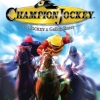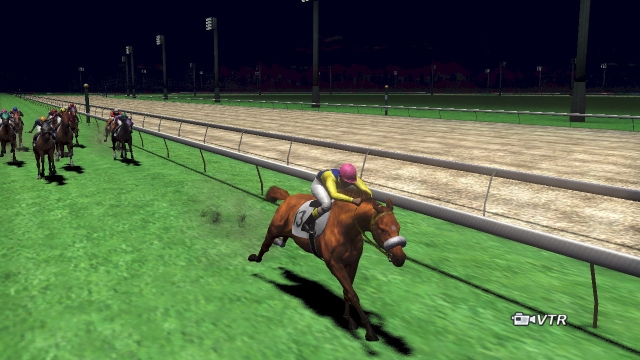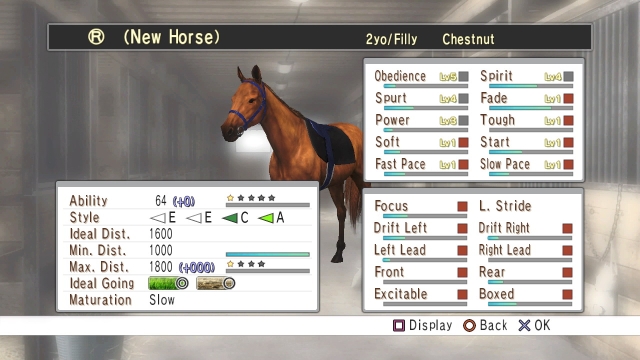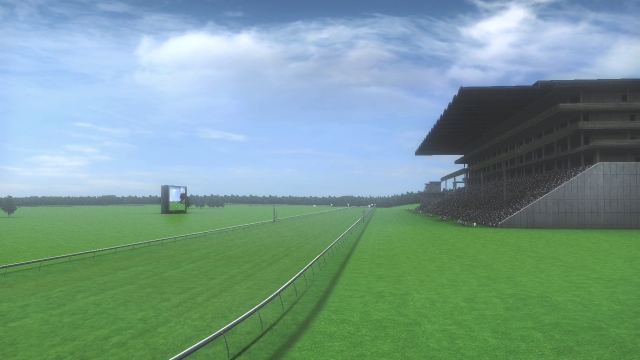Champion Jockey Review
 Game: Champion Jockey: G1 Jockey & Gallop Racer
Game: Champion Jockey: G1 Jockey & Gallop Racer
Developer: Koei-Tecmo
Publisher: Tecmo-Koei
Available on: Xbox 360, PlayStation 3, Nintendo Wii (PlayStation 3 Version Reviewed)
Horse Racing – not the most obvious fodder for video game design. Gamers might think of Final Furlong, the Namco arcade game where you literally ride a rocking horse backwards and forwards in a frantic attempt at finishing the race in a respectful position. Some other arcade hangers-on might bring up mention of SEGA’s Derby Owner’s Club, one of the many card-based games the house of Sonic worked on in the early 2000’s, where players would save their horse data on a card and train and breed their steed in order to build the perfect racing machine.
But speak to console gamers and most of them will have no experience of Horse Racing titles at all. The G1 Jockey series from Tecmo Koei has been the only option for equine lovers on console, and it has only ever reached out to a wide market in Japan. Most iterations of the game were released on PlayStation 2, but it was the Wii version that finally proved to be the breakthrough title in the series.
It seems that (just like Final Furlong before it) motion control and movement seems to be the attractive aspect of a Horse Racing title to the Western market. So the bigwigs at Tecmo Koei went about greenlighting the latest title in the series, now known as Champion Jockey: G1 Jockey & Gallop Racer, that makes use of the motion control of Wii, Move on PlayStation 3 and Kinect for Xbox 360. The title isn’t based purely on motion control however, rather motion is simply optional. The core of the game is an RPG-style Story Mode, which is deep and complex, and unlike anything you would find in a Western sports title.
STORY: You and three friends are apprentice jockeys who have just passed training and have now gained their professional licenses which will entitle them to enter the racing circuit. Players get to create their own jockey, from naming them, to picking a representative image and designing their own racing silks (which you strangely wear rarely in-game). Upon creating a racer, you will have to choose the breeder and stables that will form your home stable, who you will get the majority of yuor race rides from. The career is split up into weeks, months and years, with players being able to participate in a weekend of racing, one training session and one workout each week.
As you progress, you will get the opportunity to choose a male and female horse with which to breed a young foal who you will then be given a year to train, week by week, before it is adjudged ready to enter the racing world. In the meantime, you can use preset horses from your home stable or you can negotiate with other stables to ride their horses. Win more races and your reputation will improve and you will be able to enter bigger races and have the chance to win awards and trophies. You will also check back with your group of friends from time to time, in order to see how everyone is progressing and to take part in personal challenges between your group.
GRAPHICS: Unfortunately the graphics are certainly nothing to write home about. Comparing this latest title to past PlayStation 2 and Wii versions, there has not been much improvement made. Of course, high definition graphics allow for a slightly crisper and smoother display, but in terms of animation and character models, these are fairly simple and have changed very little over the years. The actual animation of the horse is quite good (the leg movement in particular is impressively realistic) but the detail in the textures and environments leaves quite a lot to be desired.
Menu graphics are all fairly simple and plain, and the game really does look more like a management game, or the menus of a role-playing title, what with the uninspired layout and visuals. Characters are drawn in 2D, in a vaguely Anime style in the Story Mode screens, which does allow for their individual character to show through more than if they were simply the in-race 3D racer models, and this goes towards giving the game a very Japanese feel, which is certainly not a bad thing, but it may alienate some gamers who are looking for the Western ideal of a super realistic sporting title.
SOUND: Sound isn’t a particularly strong point of the title due to some minor issues, but it is functional enough and the effects are nicely implemented. The raceday sounds such as the clomping of hooves, flicking of whips and the roar of the crowd all build up an atmosphere of expectation and excitement for the race, the background music is a real mixed bag of dramatic inspirational tunes, to annoying light hearted melodies. There is an option before each race as to whether you would like background music or simply the race sound effects, but more often than not you will likely find yourself riding with just the racing sounds. This creates a far more tense and exciting atmosphere, and cuts out the irritating and repetitive music. The lack of voices in the Story Mode is a minor irritation, as there can be a lot of text to read in some of the conversations, but it is once again, not a strong negative point.
GAMEPLAY: The game eases you in with a few weeks of tutorial modes before the full season gets underway. These training races slowly teach you the basics of the control systems, as well as making it clear what all the different meters and warnings on your heads-up display represent. This is all very important, as you will need to balance several different aspects in each race in order to achieve success. The tutorials also go about telling you how you will pick your horses to ride each week, and how to negotiate well. It is very rare that you are given a horse to ride, so each week you will look at the week’s races and the available horses for each race.
From here you must use your racing points (earned in each race – more or less, dependant on where you finish) to either accept offers from stable owners you are already on good terms with, or to request rides on horses who may already be earmarked for another rider. This is a gamble, as unless the horse is already offered to you, there is a chance you could lose the racing points you bid, without a successful negotiation. This will leave you still looking for a ride, but with less to spend. It is a balancing act whereby you might only choose to gamble if you know you are on good terms with the stable owner already, and have done well for them in the past. This builds up a good relationship and will mean more options in the future. Get a few good relationships and you could find yourself riding in multiple races each week – which will certainly speed you on your way to that coveted Rookie of the Year trophy.
After finding a horse to ride, you can take them to the stables to workout. Working out will improve the current form of the horse, giving it a little extra boost in the race itself. The workouts take the form of several different exercises with specific goals assigned to them. For example, you might be asked to race 1000 metres on a horse with low stamina, but finish in under 39 seconds. For another, you may be asked to ride side by side with a horse, for as long as possible within a set time period. These are all quite difficult, and you will need to learn the best tactics for each exercise in order to complete them effectively. When you can’t work out the right technique needed to get good results, it can get very frustrating as some of the workouts do require very precise actions, and this might put some players off. There is an auto-train mode, but this is very hit and miss as to whether it will achieve good or bad results, and is best steered clear of.
If you have been approached by your home stable to breed a young horse, training will take the same form as workouts, yet each exercise is designed to improve a particular ability of the horse, and not just its current form. You can train the horse once each week for the first half of the season, up until it is due to make its debut. The horse will start with a few strengths based on the abilities of the parents you chose for it, but it will also have many weaknesses that you must address by successfully completing the correct training exercises. Complete enough exercises well and a weakness disappears, train it further and it might have the chance to turn into a positive ability. Successfully breeding a championship winning horse is even more satisfying than using a default one – seeing your baby come of age!
After all of this preparation, it is time to race your horse. You can choose easy, normal or hard difficulties, and there is the choice between normal or professional control methods. These options all help you tweak the game to the exact difficulty you want to try. You can even customise your own control method, where you can turn some of the assist methods on and off as you wish, in order to get a perfect balance. In whichever control method, it can be controlled using the game pad, or the motion controller of choice. The motion controls consist of obvious actions such as pushing your hands forward to speed up, pulling back to pull on the reigns and slow down, and performing a whipping action in order to whip. They are all fairly self explanatory and in that sense, logical. But, because the game is so much about finding the right balance between different aspects of the race, I think the precision of a control pad might still be preferential.
In a standard race the player must take into consideration the stamina of the horse, its preferred racing position (be it front runner, pack runner or rear runner, for example) what abilities it possesses and the preferred distance the horse likes to run. Obviously, for a race with jumps in it, you would want to ideally pick a horse with the “likes jumping” ability, and similarly in a 1200 Metre race, you would pick one whose ideal race length is 1200 Metres. By matching all of these aspects, you can give your horse a further performance boost in the race. These all contribute to your “Revolution” meter. Fill it and your horse will get a second wind at the end of the race, giving it a fantastic chance at winning the race. Make a good start and this will fill your meter. Race in the preferred position of the horse, it will fill further, and so on.
You control pushing the horse to go faster, pulling on the reigns to slow down, steering left or right and whipping with a selection of different whipping actions. You must choose carefully at what point in the race it is best to begin whipping and making your move for first place, without running down your stamina too early. Your horse also possesses a Potential meter, which fills during the race, depending on if the horse is happy in its position and how it is being ridden. It is good to build up as much potential as possible, as this will act as back-up stamina when your horse is running on empty, allowing you to get a boost even when you have no energy, but whip too much and your horse may become fatigued or even injured. There are even jump races to consider, which adds another layer of challenge to the race. Concentrate on making perfect jumps, or keep an eye on your speed and the other horses? It is a difficult balance, but only adds to the challenge, and in turn, the satisfaction when you are successful. But fail to pull it off correctly and you might take a tumble and end up unable to ride for some time through injury!
As well as the Story Mode and one-off race options, there is the Scenario Challenge, which involves preset races on your own bred horses from the story Mode. Can you win in difficult conditions? Also there is a mode called the Quest Challenge, where players select from preset horses for preset races, which form a tournament or mini storyline of sorts. This is more of a story mode for those who don’t want to invest all the time into training and working out their horses – an arcade tournament if you will. A rather clever idea is the fact that players can save replays after a race, and then come back to them later to in Replay Race mode. This loads up a new race, but using all the options and settings from the race you saved the replay of. Could you repeat the glory of that big win? Or maybe you saved the replay of a very tough race, so that you could practice it more until you get it just right? There are many options on display to hone your riding abilities.
MULTIPLAYER: There are a variety of different Multiplayer modes available, both for two players via split-screen on the same console, or for up to four players online. In terms of split-screen options,there is the choice of Free Battle in Fun Race Mode, which is a straightforward versus race, using preset horses already in the game in a head to head race. Then there is the choice of the standard Free Battle, where you can select your own horses and track to race on, and it does involve a full field of computer controlled horses. Choose a more even field of horses, or challenge yourself by selecting stronger opponents to race against. Finally, we come to Scenario Battle, where the two players race a predetermined race, using horses that the players have bred themselves. Unfortunately, due to this mode requiring both players to have bred horses, this is a mode that isn’t very easy to pick up and play, so it is unlikely that you will even get the chance to try this out very often.
Online multiplayer options however are surprisingly limited. Choose between either a ranked or player match and that is more or less all you can do online. Horses can be selected from existing ones or player-bred ones, but there is no choice for pure head-to-head racing or Scenario modes, just a simple full-field race. It also seems strange that in a race with a field of around 16 horses (for example) the game only supports four players in online play. Surely a full field made up of human players would have been quite an enticing prospect for players? There is also an online ranking system, but this is more or less your common or garden Leaderboard.
LONGEVITY: As covered before, there is a multitude of different modes to play through, and whilst the scenario and challenge modes will add a considerable amount of length to the experience, it is the expansive and engrossing Story Mode that is likely to keep drawing players back in for another race. Due to the ratcheting difficulty levels and the option to change your control style to a more difficult one as you get used to the nuances of the control methods, the game really has some legs to it. You can work your way up from being a beginner to using professional controls at the most demanding difficulty and the more you play, the more you learn about how to get the best from different horses. So the game really continues to expand as you get further into the title.
Of course, if you don’t get hooked by the Story Mode, the other options in the game will soon feel rather shallow. There is little reward or reason to want to participate in individual races and a lot of the other modes require the player to import a horse from their career save game before that mode of gameplay can even be started. On top of that, the multiplayer experience is not likely to be one that will be played for long as the lack of tournament creation and competition in multiplayer severely limits its lifespan.
VERDICT: If one were to take aside the Story Mode in the game, this title would feel incredibly shallow and certainly a poor representation of the sport. But in reality, the game is all about the Story Mode and what a Story Mode it is. There is something strangely compelling about establishing yourself as a successful Jockey, making connections with new stable owners and rearing your own thoroughbred, with the hopes that it will fulfill its potential and one day be a champion steed. The RPG style presentation and design does an excellent job of making the game intriguing and addictive – what with all the little options and the training you can go through in order to improve your chances of riding to glory.
The addition of motion controls to the title may be the factor that will draw in a new audience of players, but unfortunately they may not be the correct audience that will appreciate the nuances and foibles of the title. Motion control remains a market that is predominantly palyed by the casual gamer, and unfortunately the casual player is unlikely to take to the Story Mode with as much gusto as some more hardcore gamers. I hope they do, as it is a fun, unusual and ultimately amusing mode that demands your attention and will keep you wanting just one more race. It is a rewarding experience that keeps you interested despite the sometimes dodgy translation and the often goofball conversations. Keep at it and you will see what it takes to become a Champion Jockey.











